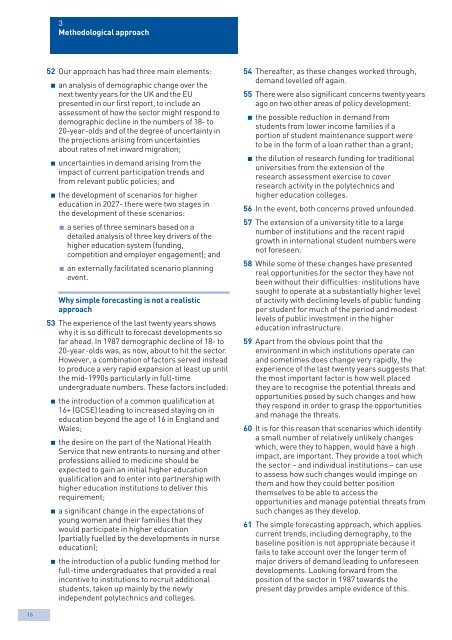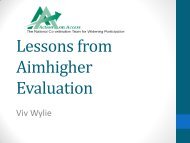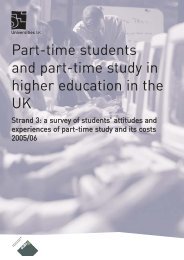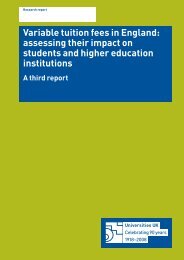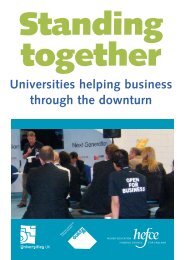The future size and shape of HE - Universities UK
The future size and shape of HE - Universities UK
The future size and shape of HE - Universities UK
- No tags were found...
You also want an ePaper? Increase the reach of your titles
YUMPU automatically turns print PDFs into web optimized ePapers that Google loves.
3Methodological approach52 Our approach has had three main elements:p an analysis <strong>of</strong> demographic change over thenext twenty years for the <strong>UK</strong> <strong>and</strong> the EUpresented in our first report, to include anassessment <strong>of</strong> how the sector might respond todemographic decline in the numbers <strong>of</strong> 18- to20-year-olds <strong>and</strong> <strong>of</strong> the degree <strong>of</strong> uncertainty inthe projections arising from uncertaintiesabout rates <strong>of</strong> net inward migration;p uncertainties in dem<strong>and</strong> arising from theimpact <strong>of</strong> current participation trends <strong>and</strong>from relevant public policies; <strong>and</strong>p the development <strong>of</strong> scenarios for highereducation in 2027- there were two stages inthe development <strong>of</strong> these scenarios:p a series <strong>of</strong> three seminars based on adetailed analysis <strong>of</strong> three key drivers <strong>of</strong> thehigher education system (funding,competition <strong>and</strong> employer engagement); <strong>and</strong>p an externally facilitated scenario planningevent.Why simple forecasting is not a realisticapproach53 <strong>The</strong> experience <strong>of</strong> the last twenty years showswhy it is so difficult to forecast developments s<strong>of</strong>ar ahead. In 1987 demographic decline <strong>of</strong> 18- to20-year-olds was, as now, about to hit the sector.However, a combination <strong>of</strong> factors served insteadto produce a very rapid expansion at least up untilthe mid-1990s particularly in full-timeundergraduate numbers. <strong>The</strong>se factors included:p the introduction <strong>of</strong> a common qualification at16+ (GCSE) leading to increased staying on ineducation beyond the age <strong>of</strong> 16 in Engl<strong>and</strong> <strong>and</strong>Wales;p the desire on the part <strong>of</strong> the National HealthService that new entrants to nursing <strong>and</strong> otherpr<strong>of</strong>essions allied to medicine should beexpected to gain an initial higher educationqualification <strong>and</strong> to enter into partnership withhigher education institutions to deliver thisrequirement;p a significant change in the expectations <strong>of</strong>young women <strong>and</strong> their families that theywould participate in higher education(partially fuelled by the developments in nurseeducation);p the introduction <strong>of</strong> a public funding method forfull-time undergraduates that provided a realincentive to institutions to recruit additionalstudents, taken up mainly by the newlyindependent polytechnics <strong>and</strong> colleges.54 <strong>The</strong>reafter, as these changes worked through,dem<strong>and</strong> levelled <strong>of</strong>f again.55 <strong>The</strong>re were also significant concerns twenty yearsago on two other areas <strong>of</strong> policy development:p the possible reduction in dem<strong>and</strong> fromstudents from lower income families if aportion <strong>of</strong> student maintenance support wereto be in the form <strong>of</strong> a loan rather than a grant;p the dilution <strong>of</strong> research funding for traditionaluniversities from the extension <strong>of</strong> theresearch assessment exercise to coverresearch activity in the polytechnics <strong>and</strong>higher education colleges.56 In the event, both concerns proved unfounded.57 <strong>The</strong> extension <strong>of</strong> a university title to a largenumber <strong>of</strong> institutions <strong>and</strong> the recent rapidgrowth in international student numbers werenot foreseen.58 While some <strong>of</strong> these changes have presentedreal opportunities for the sector they have notbeen without their difficulties: institutions havesought to operate at a substantially higher level<strong>of</strong> activity with declining levels <strong>of</strong> public fundingper student for much <strong>of</strong> the period <strong>and</strong> modestlevels <strong>of</strong> public investment in the highereducation infrastructure.59 Apart from the obvious point that theenvironment in which institutions operate can<strong>and</strong> sometimes does change very rapidly, theexperience <strong>of</strong> the last twenty years suggests thatthe most important factor is how well placedthey are to recognise the potential threats <strong>and</strong>opportunities posed by such changes <strong>and</strong> howthey respond in order to grasp the opportunities<strong>and</strong> manage the threats.60 It is for this reason that scenarios which identifya small number <strong>of</strong> relatively unlikely changeswhich, were they to happen, would have a highimpact, are important. <strong>The</strong>y provide a tool whichthe sector – <strong>and</strong> individual institutions – can useto assess how such changes would impinge onthem <strong>and</strong> how they could better positionthemselves to be able to access theopportunities <strong>and</strong> manage potential threats fromsuch changes as they develop.61 <strong>The</strong> simple forecasting approach, which appliescurrent trends, including demography, to thebaseline position is not appropriate because itfails to take account over the longer term <strong>of</strong>major drivers <strong>of</strong> dem<strong>and</strong> leading to unforeseendevelopments. Looking forward from theposition <strong>of</strong> the sector in 1987 towards thepresent day provides ample evidence <strong>of</strong> this.16


